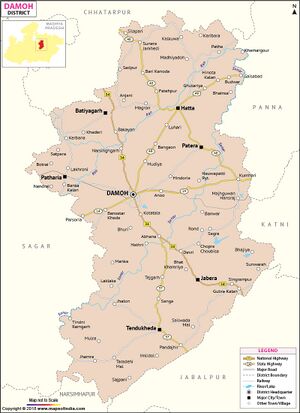Pipariya Ghanshyam
| Author:Laxman Burdak, IFS (R) |



Pipariya Ghanshyam is a village in Batiagadh tahsil in Damoh district of Madhya Pradesh. It is site of Sati inscriptions.
Variants
Location
Pipariya Ghanshyam is a small Village/hamlet in Batiyagarh Tehsil in Damoh District of Madhya Pradesh State, India. It comes under Pipariya Ghanshyam Panchayath. It belongs to Sagar Division . It is located 50 KM towards North from District head quarters Damoh. 19 KM from Batiagarh. 280 KM from State capital Bhopal. Pipariya Ghanshyam Pin code is 470775 and postal head office is Hatta (Damoh). Harduajamsa ( 6 KM ) , Sagron ( 8 KM ) , Magron ( 8 KM ) , Doli ( 11 KM ) , Ghughas ( 12 KM ) are the nearby Villages to Pipariya Ghanshyam. Pipariya Ghanshyam is surrounded by Hatta Tehsil towards East , Buxwaha Tehsil towards west , Patera Tehsil towards South , Pathariya Tehsil towards South. This Place is in the border of the Damoh District and Chhatarpur District. Chhatarpur District Buxwaha is west towards this place.[1]
Origin
Jat Gotras Namesake
History
Damoh Sati Inscriptions
There are a number of Sati pillars in this district, those at Hata, Hindoria and Batihagarh being well known. One of them at Hindoria is dated in 1056 AD, Bhiloni, Phutera, Jamata, Kanoda Ryotwari, Kanti, Kaithora Khamargor, Muhas, Marhiadoh, Narainpura, Piparia Ghanshiam, Raneh, Sunwaho and Sakhor contain more or less illegible inscriptions.
Reference - Hira Lal: Descriptive lists of inscriptions in the Central provinces and Berar,p.53
(98) Piparia Memorial Pillars 1141 AD
Source - Inscriptions in the Central Provinces and Berar by Rai Bahadur Hira Lal, Nagpur, 1932
[p.56]: Piparia is a deserted village a mile from Fatahpur, which is 27 miles from Hata. It appears that a battle was fought there and memorials were raised on the spot where the warriors fell. There are five pillars depicting the scene of fight, two of which are dated. Both record the date as Friday, the 11th of the dark fortnight of Ashvina in samvat 1198 , corresponding to the Friday 29th August 1141 AD, when King Mahamandalika Ranaka Jayatsimha (राणक जयत्सिंह) fought with prince Hemasimha (हेमसिंह). Jayatsimha is shown as pursuing the enemy. He has killed a prince, who is lying on the ground while Maharajaputra Gopaladeva is after prince Ranashaila(रणशैल). Another prince Damodara rides a huge horse named Simhamani (सिंहमणि) and is chasing four princes, who are running away. One is down on the ground.
(113) Other Sati Inscriptions
Source - Inscriptions in the Central Provinces and Berar by Rai Bahadur Hira Lal, Nagpur, 1932,p.61-62
[p.61]: Damoh district also contains a very large number of Sati pillars, most of which are dated and mention the ruling kings, which are very useful in elucidating the history of the district. The more important ones have been noticed separately under section A. Others exist in Bangaon (बनगाँव), Banwar (बनवार), Batiagarh (बटियागढ़), Bhiloni (भिलोनी), Bandakpur (बांदकपुर), Chilghat (चीलघाट), Deogaon (देवगाँव), Hata (हटा), Hindoria (हिंडोरिया), Jamata (जामटा), Jhadoli (झडोली), Kanoda (कनोड़ा), Kanti (कांटी), (p.62), Kaithora (कैथोरा), Khamargaur (खमरगौर), Lukayan (लुकायन), Lakhroni (लखरोनी), Muhas (मुहास), Madhiadoh (मढ़ियादोह), Phutera (फुटेरा), Patna (पटना), Panari Mahant (पनारी महंत), Narsinghgarh (नरसिंहगढ़), Narainpura (नरायणपुरा), Pipariya Ghanshyam (पिपरिया घनश्याम), Puranakhera (पुराना खेड़ा), Raneh (रनेह), Sunwaho (सुनवाहो), Satsuma (सतसूमा), Sakaur (सकुर), Sailwara (सैलवाड़ा), Sitanagar (सीतानगर),
These belong to various periods and mention names of various kings and emperors notably almost all the Khilji kings of Malwa and Delhi emperors of more than one dynasty.

